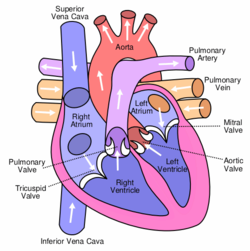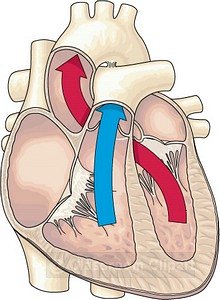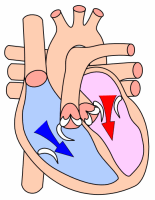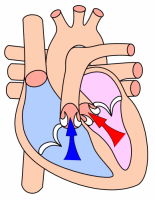Heart
|
|
The heart (Latin cor) is a hollow, muscular organ that pumps blood through the blood vessels by repeated, rhythmic contractions. The term cardiac means "related to the heart", from the Greek kardia (καρδια) for "heart".
| Contents |
The human heart
Structure
In the human body, the heart is normally situated slightly to the left of the middle of the thorax, underneath the sternum (breastbone). It is enclosed by a sac known as the pericardium and is surrounded by the lungs. In adults, it weighs about 300-350 g. It consists of four chambers, the two upper atria (singular: atrium) and the two lower ventricles.
A thick muscular wall, the septum, divides the right atrium and ventricle from the left atrium and ventricle, preventing blood from passing between them. Valves between the atria and ventricles (atrioventricular valves) maintain coordinated unidirectional flow of blood from the atria to the ventricles.
The left ventricle pumps blood throughout the body's arteries and veins; the right ventricle pumps blood to the lungs. Compared with the walls of the atria, the ventricle walls are thicker.

Oxygen-depleted or deoxygenated blood from the body enters the right atrium through two great veins, the superior vena cava which drains the upper part of the body and the inferior vena cava that drains the lower part. The blood then passes through the tricuspid valve to the right ventricle. The right ventricle pumps the deoxygenated blood to the lungs, through the pulmonary artery. In the lungs gaseous exchange takes places and the blood releases carbon dioxide into the lung cavity and picks up oxygen. The oxygenated blood then flows through pulmonary veins to the left atrium. From the left atrium this newly oxygenated blood passes through the mitral valve to enter the left ventricle. The left ventricle then pumps the blood through the aorta to the entire body except the lungs.
The left ventricle is much more muscular than the right as it has to pump blood around the entire body, which involves exerting a considerable force to overcome the vascular pressure. As the right ventricle needs to pump blood only to the lungs, it requires less muscle.
Even though the ventricles lie below the atria, the two vessels through which the blood exits the heart (the pulmonary artery and the aorta) leave the heart at its top side.
The contractile nature of the heart is due to the presence of cardiac muscle in its wall which can work continuously without fatigue. The heart wall is made of three distinct layers. The first is the outer epicardium which is composed of a layer of flattened epithelial cells and connective tissue. Beneath this is a much thicker myocardium made up of cardiac muscle. The endocardium is a further layer of flattened epithelial cells and connective tissue which lines the chambers of the heart.
The blood supply to the heart itself is supplied by the left and right coronary arteries, which branch off from the aorta.
The cardiac cycle
The function of the heart is to pump blood around the body. Every single beat of the heart involves a sequence of events known as the cardiac cycle, which consists of three major stages: atrial systole, ventricular systole and complete cardiac diastole. The atrial systole consists of the contraction of the atria and the corresponding influx of blood into the ventricles. Once the blood has fully left the atria, the atrioventricular valves, which are situated between the atria and ventricular chambers, close. This prevents any backflow into the atria. It is the closing of the valves that produces the familiar beating sounds of the heart, commonly referred to as the "lub-dub" sound.
The ventricular systole consists of the contraction of the ventricles and flow of blood into the circulatory system. Again, once all the blood empties from the ventricles, the pulmonary and aortic semilunar valves close. Finally complete cardiac diastole involves relaxation of the atria and ventricles in preparation for refilling with circulating blood.
Regulation of the cardiac cycle
Cardiac muscle is myogenic, which means that it is self-exciting. This is in contrast with skeletal muscle, which requires either conscious or reflex nervous stimuli. The heart's rhythmic contractions occur spontaneously, although the frequency or heart rate can be changed by nervous or hormonal influences such as exercise or the perception of danger.
The rhythmic sequence of contractions is coordinated by the sinoatrial and atrioventricular nodes. The sinoatrial node, often known as the cardiac pacemaker, is located in the upper wall of the right atrium and is responsible for the wave of electrical stimulation (See action potential) that initiates atria contraction. Once the wave reaches the atrioventricular node, situated in that separates the ventricular chambers, it is conducted through the bundles of His and causes contraction of the ventricles. The time taken for the wave to reach this node from the sinoatrial nerve creates a delay between contraction of the two chambers and ensures that each contraction is coordinated simultaneously throughout all of the heart. In the event of severe pathology, the Purkinje fibers can also act as a pacemaker; this is usually not the case because their rate of spontaneous firing is considerably lower than that of the other pacemakers and hence is overridden.
Diseases and treatments
The study of diseases of the heart is known as cardiology. Important diseases of the heart include:
- Coronary heart disease is the lack of oxygen supply to the heart muscle; it can cause severe pain and discomfort known as Angina.
- A heart attack occurs when heart muscle cells die because blood circulation to a part of the heart is interrupted.
- Congestive heart failure is the gradual loss of pumping power of the heart.
- Endocarditis and myocarditis are inflammations of the heart.
- Cardiac arrhythmia is an irregularity in the heartbeat. It is sometimes treated by implanting an artificial pacemaker
- Congenital heart defects.
If a coronary artery is blocked or narrowed, the problem spot can be bypassed with coronary artery bypass surgery or it can be widened with angioplasty.
Beta blockers are drugs that lower the heart rate and blood pressure and reduce the heart's oxygen requirements. Nitroglycerin and other compounds that give off nitric oxide are used to treat heart disease as they cause the dilation of coronary vessels.
At Groote Schuur Hospital in Cape Town, South Africa, 53-year-old Lewis Washkansky on December 3, 1967 became the first human to receive a heart transplant (however he died 18 days later from double pneumonia). The transplant team was headed by Christiaan Barnard.
See also: Cardiology diagnostic tests and procedures
First Aid
See cardiac arrest for emergencies involving the heart
If a person is encountered in cardiac arrest (no heartbeat), cardio-pulmonary resuscitation (i.e., CPR) should be started.
The hearts of other animals
Structure
The structure of the heart of other mammals is quite similar to that of humans, with four chambers. Birds also have a four-chambered heart, however it is thought that this evolved independently of that of mammals. Amphibians have a three-chambered heart. Reptilia also have a three-chambered heart, except from crocodylians, which have four. Fish have a single circulation system and a heart with two chambers. The hearts of arthropods and mollusks have a single chamber.
Heartbeat
Smaller animals have faster heartbeat. This is evident within a species as well, as the young beat their hearts faster than the adults. Gray Whale beats 9 times per minute, Harbour Seal 10 when diving, 140 when on land, elephant 25, human 70, sparrow 500, shrew 600, and hummingbird 1,200 when hovering.
The earthworm has a series of multiple primitive hearts.
Food use
The hearts of cattle, sheep, pigs and certain fowl are consumed as food in many countries. They are counted among offal, but being a muscle, the taste of heart is much more like regular meat than that of other offal. Since the heart is always moving, even in barn animals, it resembles venison in structure and taste.
See also
- Atrium
- Ventricle
- Cardiology
- Cardiovascular pathology
- Circulatory system
- Haemodynamics
- Heart defects
- Heart rate
- Pulse
- Blood pressure
Anatomy Clipart and Pictures
- Clip Art (http://classroomclipart.com)
- Anatomy Clip Art (http://classroomclipart.com/cgi-bin/kids/imageFolio.cgi?direct=Anatomy)
- Anatomy Clip Art (http://classroomclipart.com/cgi-bin/kids/imageFolio.cgi?direct=Clipart/Anatomy)
- Anatomy Animations (http://classroomclipart.com/cgi-bin/kids/imageFolio.cgi?direct=Animations/Anatomy)
- Anatomy Illustrations (http://classroomclipart.com/cgi-bin/kids/imageFolio.cgi?direct=Illustrations/Anatomy)
External links
- Free 3D Heart Images (http://www.zygote.com/DF/Heart-Anatomy-Pictures.htm)
| Cardiovascular system - Heart | Edit (http://en.wikipedia.org/w/wiki.phtml?title=MediaWiki:Heart&action=edit) |
|
Pericardium - Epicardium - Myocardium - Endocardium - Cardiac pacemaker - Sinoatrial node - Atrioventricular node - Bundle of His - Purkinje fibers - Heart valves |
| Cardiovascular system |
| Heart - Aorta - Arteries - Arterioles - Capillaries - Venules - Veins - Venae cavae - Pulmonary arteries - Lungs - Pulmonary veins - Blood |



